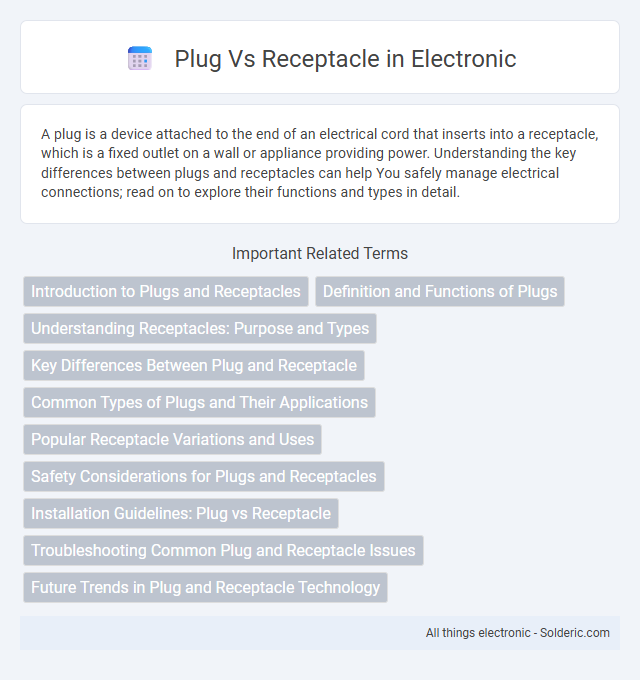A plug is a device attached to the end of an electrical cord that inserts into a receptacle, which is a fixed outlet on a wall or appliance providing power. Understanding the key differences between plugs and receptacles can help You safely manage electrical connections; read on to explore their functions and types in detail.
Comparison Table
| Feature | Plug | Receptacle |
|---|---|---|
| Definition | Male connector with prongs that insert into a receptacle. | Female connector with slots that receive a plug's prongs. |
| Function | Delivers electrical power to devices. | Provides power source connection from wiring to plug. |
| Location | Attached to electrical device cords. | Mounted on walls or panels, fixed installation. |
| Design | Protruding pins/prongs for insertion. | Recessed slots or holes for receiving prongs. |
| Safety | Exposed prongs require careful handling. | Typically includes grounding and safety mechanisms. |
| Examples | Power cord plug, appliance plug. | Wall outlet, power strip socket. |
Introduction to Plugs and Receptacles
Plugs and receptacles form the essential components of electrical connection systems, with plugs serving as the male connectors that insert into receptacles, the female counterparts mounted on walls or devices. Their design variations accommodate different voltage ratings, current capacities, and safety standards across residential, commercial, and industrial applications. Understanding the distinction between plug types and compatible receptacles ensures safe and efficient power delivery while preventing electrical hazards.
Definition and Functions of Plugs
Plugs are electrical devices designed to connect a power source to an electrical appliance, enabling the flow of electricity through a secure and standardized interface. Their main functions include ensuring safe electrical contact, preventing accidental shocks, and allowing easy disconnection of devices. Understanding the role of plugs helps you choose compatible equipment and maintain electrical safety in your home or workplace.
Understanding Receptacles: Purpose and Types
Receptacles are electrical outlets designed to provide a secure connection point for plugs, allowing electrical devices to access power safely. Common types include duplex receptacles, ground fault circuit interrupters (GFCI) for wet locations, and tamper-resistant receptacles for child safety. Understanding the purpose and specific type of receptacle ensures Your electrical devices connect properly and operate safely within different environments.
Key Differences Between Plug and Receptacle
The key differences between a plug and a receptacle lie in their roles in electrical connections: a plug is a device with prongs that fits into a receptacle to establish an electrical circuit, while a receptacle is a fixed component mounted on walls or appliances to receive the plug. Plugs are typically attached to cords, allowing portable devices to connect to power sources, whereas receptacles are part of the building's electrical infrastructure designed for permanent installation. Understanding these distinctions ensures safe and effective use of your electrical equipment.
Common Types of Plugs and Their Applications
Common types of plugs include Type A and B used predominantly in North America for household appliances, Type C popular across Europe for general electrical devices, and Type G found primarily in the UK and Ireland for higher-powered equipment. Industrial settings often utilize specialized plugs like the NEMA connectors in the United States, designed to handle high voltage and current requirements safely. Each plug type pairs with a corresponding receptacle to ensure compatibility, safety, and proper electrical grounding based on the application's voltage and power needs.
Popular Receptacle Variations and Uses
Popular receptacle variations include duplex, GFCI, and USB outlets, each designed for specific uses such as general power delivery, enhanced safety in wet areas, and device charging, respectively. Duplex receptacles are the most common, suitable for residential and commercial use, while GFCI receptacles protect against electrical shock in kitchens and bathrooms. Understanding these variations helps you choose the right receptacle for your electrical needs, ensuring both functionality and safety.
Safety Considerations for Plugs and Receptacles
Safety considerations for plugs and receptacles include ensuring proper grounding to prevent electrical shock and using devices with appropriate ratings for voltage and current to avoid overloads. Plug designs with insulated pins and tamper-resistant receptacles help reduce the risk of accidental contact with live parts, especially in homes with children. Regular inspection for damage, such as frayed cords or cracked housing, is essential to maintain safe electrical connections and prevent fire hazards.
Installation Guidelines: Plug vs Receptacle
Installation of plugs and receptacles requires adherence to specific guidelines ensuring safety and functionality. Plugs must match the voltage, amperage, and configuration of the corresponding receptacle, with proper wire gauge and grounding for electrical code compliance. Receptacle installation involves secure mounting, correct wiring to circuit breakers, and verification of polarity and grounding to prevent electrical hazards.
Troubleshooting Common Plug and Receptacle Issues
Troubleshooting common plug and receptacle issues involves checking for loose connections, damaged prongs, or worn-out outlets that can cause intermittent power or complete failure. Use a multimeter to verify proper voltage supply and continuity, ensuring the receptacle is securely wired and grounded. Replacing faulty components promptly prevents electrical hazards and maintains safe, reliable power delivery in residential or commercial settings.
Future Trends in Plug and Receptacle Technology
Future trends in plug and receptacle technology emphasize enhanced smart capabilities, including integrated IoT sensors for real-time power monitoring and adaptive energy management. Innovations in materials and design aim to improve durability, safety, and environmental sustainability through eco-friendly, fire-resistant composites. Wireless power transfer and universal compatibility standards are driving the transition toward more seamless, efficient connections across diverse devices and infrastructures.
Plug vs Receptacle Infographic

 solderic.com
solderic.com